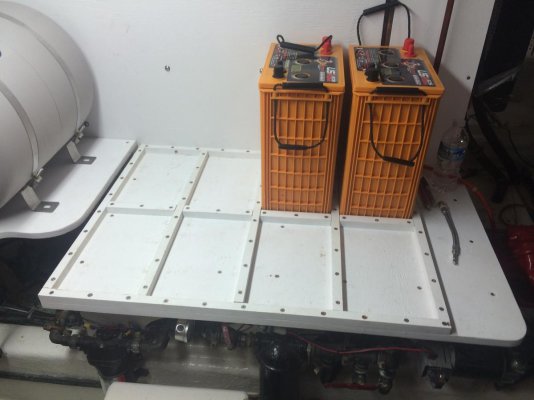I installed battery boxes into my current boat. It didn't have anything securing or protecting the batteries or terminals before that, so it made sense to go all the way.
But, it did take a bit longer than expected. I had to move the batteries all around to make room, because the boxes are much larger than the batteries, themselves.
My previous boat had battery trays, but nothing else. They worked really well, so I opted to strap the batteries down and add boots over the terminals. Those boots saved me a couple of times when I dropped tools or put them down in silly places.
When I went to look at the boat that I now own, the house batteries were nearly drained of water, hot, and warping at the top. The owner apparently knew about the problem and replaced the battery charger, thinking that it was the problem. Also, curiously enough, the photos showed three house batteries, not the two that were present when I saw the boat. Regardless, the salesperson watered the batteries that day.
I saw the new charger and the batteries boiling over and suspected the solar charger/regulator was bad and flipped it off (and told the salesperson) as I was leaving the boat.
Months later, we came to terms on the price, the boat was surveyed, engine inspected, and sea trialed. All good. I get to the boat and one of the house batteries had exploded, blowing the top off of it, and scattering plastic and what little fluid was left in it across the engine room. I'm glad I wasn't down there at the time!
What was the cause? The solar controller had settings for bulk and float charging voltages. Both were set to the very high bulk charging voltage.
What about me having switched it off months earlier? Did someone turn it back on? Nope. The breaker was a fake-out -- both wires were on the same rear screw terminal. Why would someone do that? The breaker wasn't mounted and was "floating" in line. When I tried to move the wire -- it pulled the breaker against the metal controller case and shorted. I adjusted the controller and moved and properly mounted the breaker (also added one as a cut-off panel-side).
Why would one set the float charge voltage so high? I can only guess. But, they'd pulled out one of the water tank gauges and replaced it with an amp gauge for the solar panel. I guess they wanted it show it working for the sale. But, when the batteries were charged, it showed no amps. So, I can only guess they "dialed it up" until that wasn't the case so no one would think it wasn't working. I put back the water gauge and moved that gauge near the breakers.
Regardless, I'm not sure if the battery boxes would be able to contain such a disaster -- or simply add more shrapnel. But, fortunately, adjusting the solar controller fixed the problem, so I haven't had to find out. Having said that -- I now wear safety googles when working in the engine room, not just safety glasses. And, I always use hearing protection down there. So, I'm learning. Maybe gloves will come next.






